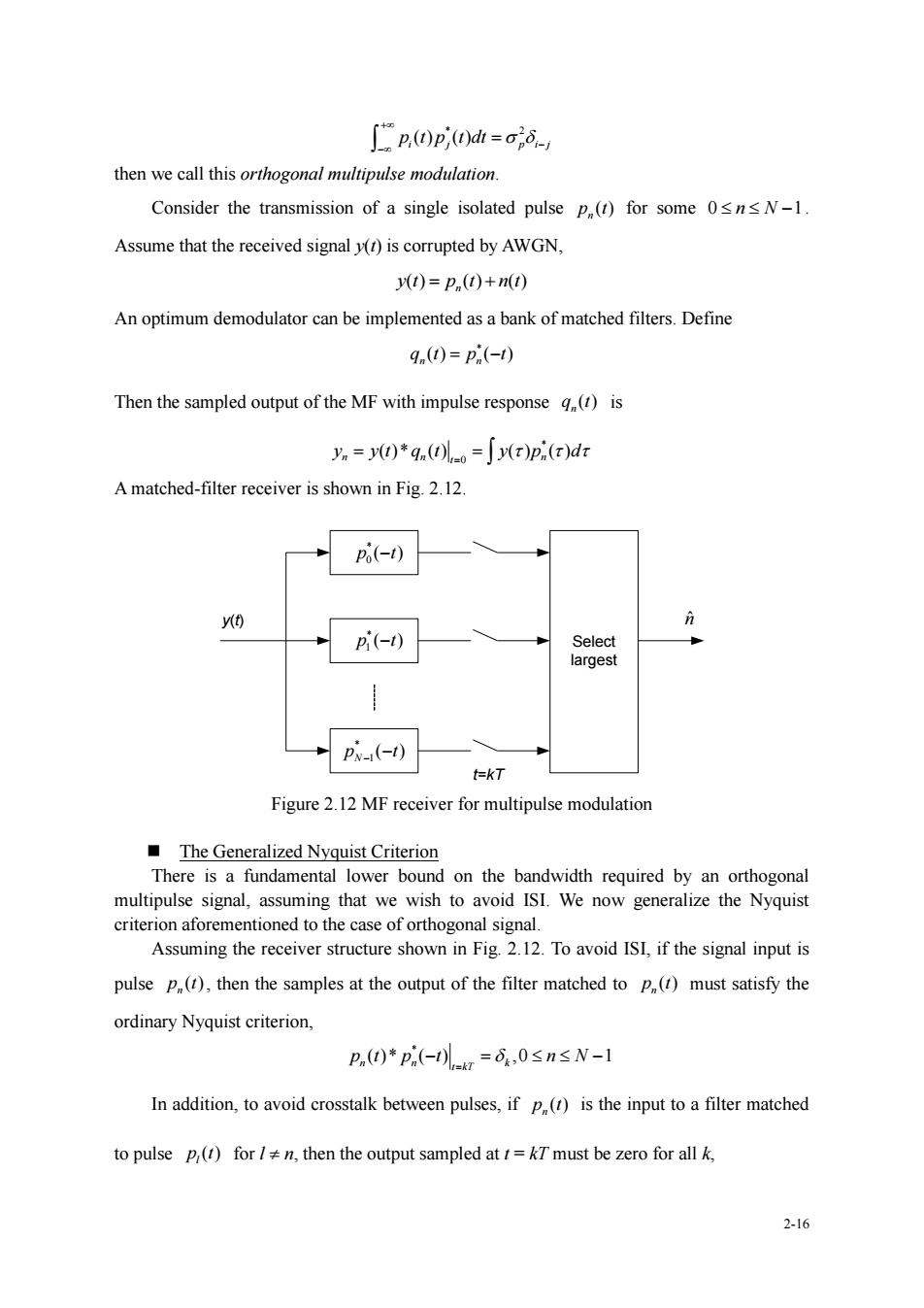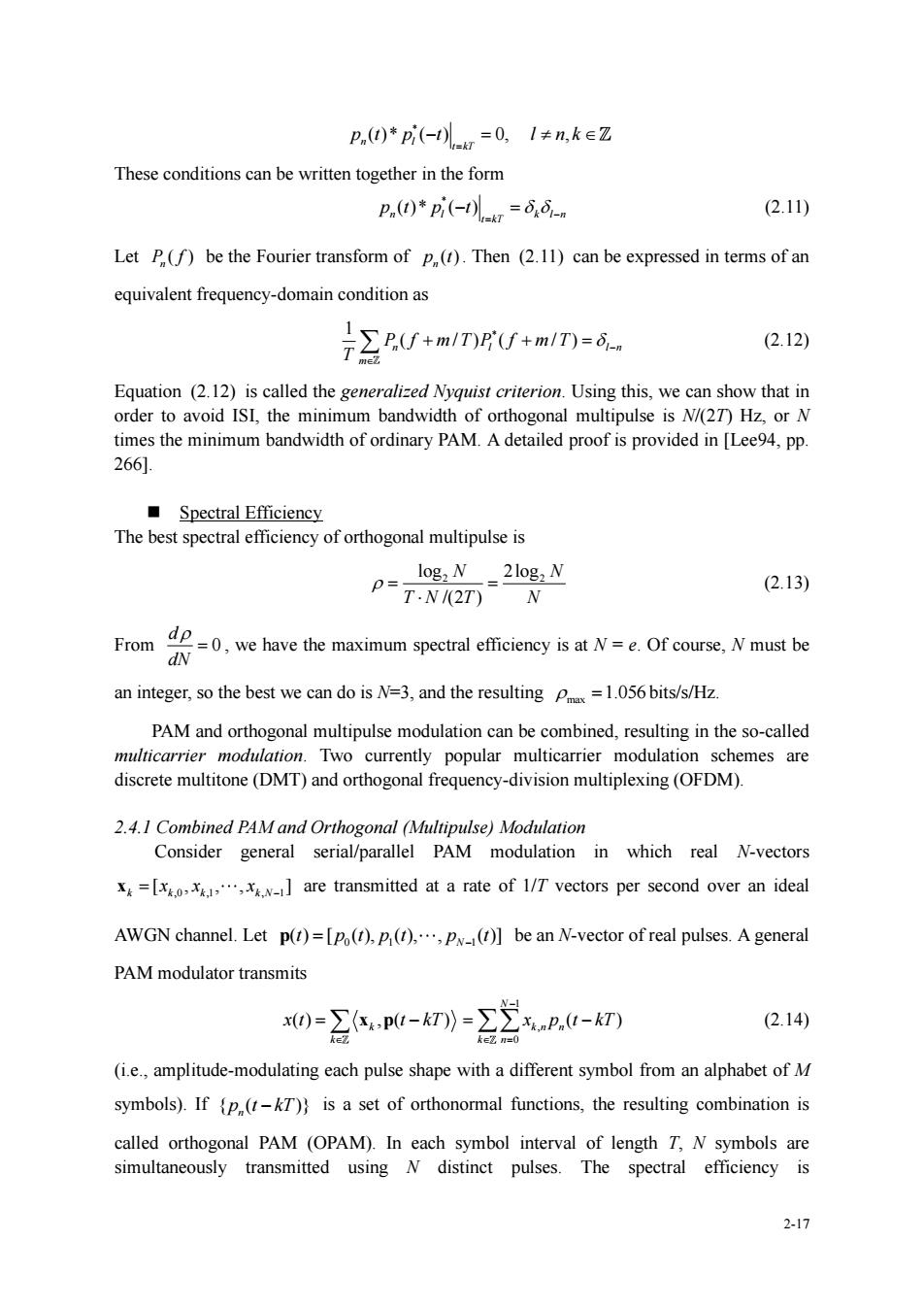
[p.(t)p;(t)dt=a6_ then we call this orthogonal multipulse modulation. Consider the transmission of a single isolated pulse p(r)for some 0snsN-1 Assume that the received signal y()is corrupted by AWGN, 0)=P()+) An optimum demodulator can be implemented as a bank of matched filters.Define g.(t)=p(-t) Then the sampled output of the MF with impulse response()is y.=y(1)q.(t)=y(r)pi(r)dr A matched-filter receiver is shown in Fig.2.12. p(-) 畅 gd +pw(-0 Figure 2.12 MF receiver for multipulse modulation The Generalized Nyquist Criterion There is a fundamental lower bound on the bandwidth required by an orthogonal multipulse signal,assuming that we wish to avoid ISI.We now generalize the Nyquist criterion aforementioned to the case of orthogonal signal. Assuming the receiver structure shown in Fig.2.12.To avoid ISI,if the signal input is pulse p(),then the samples at the output of the filter matched to p()must satisfy the ordinary Nyquist criterion, p.()*pi-=6,0≤n≤N-l In addition,to avoid crosstalk between pulses,if p.(is the input to a filter matched to pulse p()for /n,then the output sampled at t=kTmust be zero for all k. 2-16
2-16 * 2 ( ) ( ) i j p i j p t p t dt + − − = then we call this orthogonal multipulse modulation. Consider the transmission of a single isolated pulse ( ) n p t for some 0 1 − n N . Assume that the received signal y(t) is corrupted by AWGN, ( ) ( ) ( ) n y t p t n t = + An optimum demodulator can be implemented as a bank of matched filters. Define * ( ) ( ) n n q t p t = − Then the sampled output of the MF with impulse response ( ) n q t is * 0 ( )* ( ) ( ) ( ) n n n t y y t q t y p d = = = A matched-filter receiver is shown in Fig. 2.12. * 1 p t ( ) − * 1 ( ) N p t − − * 0 p t ( ) − Select largest y(t) nˆ t=kT Figure 2.12 MF receiver for multipulse modulation ◼ The Generalized Nyquist Criterion There is a fundamental lower bound on the bandwidth required by an orthogonal multipulse signal, assuming that we wish to avoid ISI. We now generalize the Nyquist criterion aforementioned to the case of orthogonal signal. Assuming the receiver structure shown in Fig. 2.12. To avoid ISI, if the signal input is pulse ( ) n p t , then the samples at the output of the filter matched to ( ) n p t must satisfy the ordinary Nyquist criterion, * ( )* ( ) ,0 1 n n k t kT p t p t n N = − = − In addition, to avoid crosstalk between pulses, if ( ) n p t is the input to a filter matched to pulse ( ) l p t for l n, then the output sampled at t = kT must be zero for all k

p.)*pi(-g=0,1≠n,keZ These conditions can be written together in the form P.(1)*Pi(-1)=6 (2.1) Let P(f)be the Fourier transform of p().Then (2.11)can be expressed in terms of an equivalent frequency-domain condition as (2.12) Equation (2.12)is called the generalized Nyquist criterion.Using this,we can show that in order to avoid ISI,the times the minimum bandwidth of ordinary PAM.A detailed proof is provided in [Lee94.pp. 2661. ■Spectral Efficiency The best spectral efficiency of orthogonal multipulse is log,N p=T-N2D)N (2.13) we have the maximum speetral efficieney is t NeOfcourse Nmust be From dp】 an integer,so the best we can do is N=3,and the resultingP=1.056bits/s/Hz. PAM and orthogonal multipulse modulation can be combined,resulting in the so-called multicarrier modulation.Two currently popular multicarrier modulation schemes are discrete multitone(DMT)and orthogonal frequency-division multiplexing(OFDM). 2.4.1 Combined PAM and Orthogonal (Multipulse)Modulation Consider general serial/parallel PAM modulation in which real N-vectors =[are transmitted at a rate of l/T vectors per second over an ideal AWGN channel.Let p(r)=[p(t).p().P()]be an N-vector of real pulses.A general PAM modulator transmits 0=,pu-k灯)=Σp.-k灯 (2.14) (i amplitude-modulating each pulse shape with a different symbol from an alphabet ofM symbols).Ifp(k is a set of orthonormal functions,the resulting combination is called orthogonal PAM (OPAM).In each symbol interval of length T,N symbols are simultaneously transmitted using N distinct pulses.The spectral efficiency is 2-17
2-17 * ( )* ( ) 0, , n l t kT p t p t l n k = − = These conditions can be written together in the form * ( )* ( ) n l k l n t kT p t p t − = − = (2.11) Let ( ) P f n be the Fourier transform of ( ) n p t . Then (2.11) can be expressed in terms of an equivalent frequency-domain condition as 1 * ( / ) ( / ) n l l n m P f m T P f m T T − + + = (2.12) Equation (2.12) is called the generalized Nyquist criterion. Using this, we can show that in order to avoid ISI, the minimum bandwidth of orthogonal multipulse is N/(2T) Hz, or N times the minimum bandwidth of ordinary PAM. A detailed proof is provided in [Lee94, pp. 266]. ◼ Spectral Efficiency The best spectral efficiency of orthogonal multipulse is 2 2 log 2log /(2 ) N N T N T N = = (2.13) From 0 d dN = , we have the maximum spectral efficiency is at N = e. Of course, N must be an integer, so the best we can do is N=3, and the resulting max =1.056 bits/s/Hz. PAM and orthogonal multipulse modulation can be combined, resulting in the so-called multicarrier modulation. Two currently popular multicarrier modulation schemes are discrete multitone (DMT) and orthogonal frequency-division multiplexing (OFDM). 2.4.1 Combined PAM and Orthogonal (Multipulse) Modulation Consider general serial/parallel PAM modulation in which real N-vectors ,0 ,1 , 1 [ , , , ] k k k k N x x x = − x are transmitted at a rate of 1/T vectors per second over an ideal AWGN channel. Let 0 1 1 ( ) [ ( ), ( ), , ( )] N t p t p t p t p = − be an N-vector of real pulses. A general PAM modulator transmits ( ) , ( ) k k x t t kT = − x p 1 , 0 ( ) N k n n k n x p t kT − = = − (2.14) (i.e., amplitude-modulating each pulse shape with a different symbol from an alphabet of M symbols). If { ( )} n p t kT − is a set of orthonormal functions, the resulting combination is called orthogonal PAM (OPAM). In each symbol interval of length T, N symbols are simultaneously transmitted using N distinct pulses. The spectral efficiency is